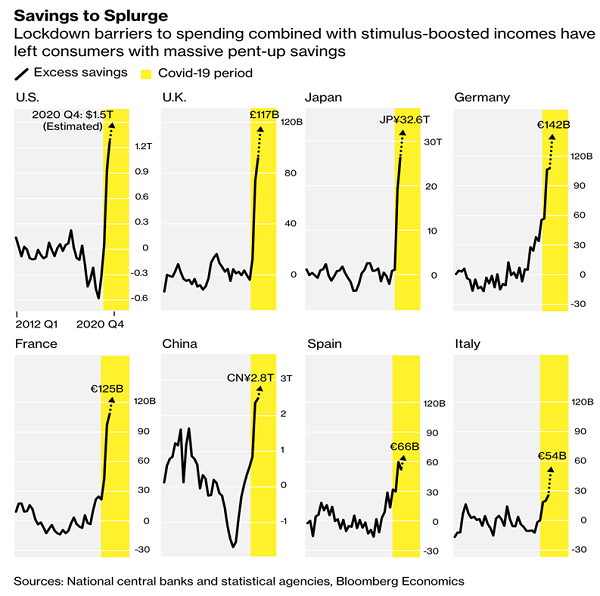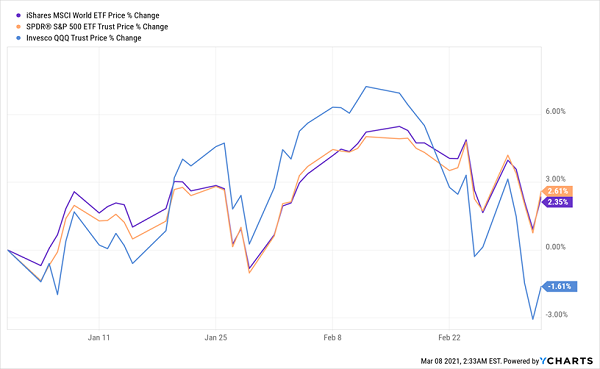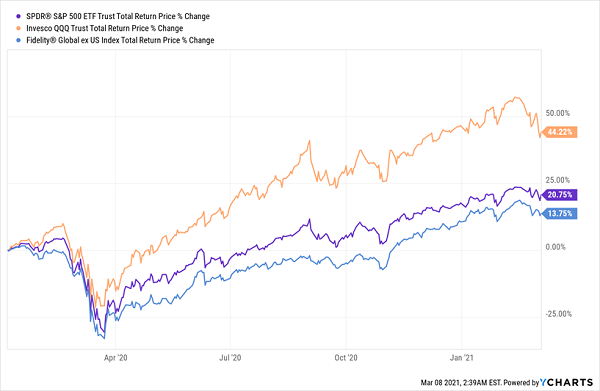The chicken littles fretting about inflation are ignoring something: the “bonus” $2.9 trillion that’s primed to ignite stocks—one group of stocks in particular.
The $2.9 trillion isn’t a new stimulus plan (although those seem to roll out daily). It’s the extra savings hoarded by consumers around the world. To put that in context, global GDP is about $89 trillion, so the total saved will amount to 3.3% of extra growth when it’s finally unleashed.

You’d think most economists would have already accounted for this savings glut in their projections. You’d also expect markets to price in this information. But neither is the case.
Cash Hoard Builds, Investors Shrug

Even with this saved-up cash ready to flow into the global economy, markets have traded pretty much flat. The NASDAQ 100 index, represented by the Invesco QQQ Trust (NASDAQ:QQQ), in blue above, is down year to date, and the S&P 500, as tracked by the SPDR® S&P 500 (NYSE:SPY), in orange, is up only marginally. Same goes for global stocks, represented above by the iShares MSCI World ETF (NYSE:URTH), in purple.
This lackluster performance is because inflation worries are dragging on stocks, with the yield on the 10-year Treasury note having nearly doubled from record lows last year. But when you factor in the pent-up demand that’s about to be unleashed, and the fact that inflation is good for stocks, since higher prices mean higher revenue and earnings in nominal-dollar terms, you get an obvious buying opportunity.
We can take advantage of this strange market moment by buying the dip, and we can amplify our gains by choosing the market that’s the most undervalued: global stocks.
Today’s Laggard Is Tomorrow’s Winner

If we zoom out to before the pandemic started, we see that the Fidelity® Global Ex U.S. Index Fund, in blue above, lags far behind the NASDAQ and the S&P 500. (As its name says, this fund excludes US stocks entirely, unlike URTH in the previous example).
While FSGGX is a great way to get into this still-underbought asset class, it isn’t the best way. Because there’s another fund with a nice collection of non-US assets and some still-undervalued US names, too. Plus we can buy this fund at a discount and get a higher yield than the 1.7% FSGGX pays.
That fund is the BlackRock (NYSE:BLK) Global Opportunities Equity Trust (NYSE:BOE), a closed-end fund (CEF) that trades at a 10% discount to net asset value (NAV, or the value of the stocks in its portfolio) and yields 6.9%—and pays dividends monthly, to boot.
We’ve seen BOE improve its portfolio in recent quarters. It’s worth noting, for example, that 20% of its portfolio is in stocks from the UK, which has been a leader in getting its people vaccinated. Meantime, BOE’s portfolio downplays some countries that have been vaccine laggards (the fund holds no stocks from Germany and Japan, for example).
A 2021-Ready Portfolio

The end result is a portfolio nicely positioned for the coming jump in consumer spending, like Amadeus IT Holding SA PK (OTC:AMADY), BOE’s seventh-largest holding, whose software is used by the travel industry. Owning this stock now, when people are eager to travel but can’t do so quite yet, is a savvy move.
Similarly, lots of pent-up spending will flow through the payment network of Visa (NYSE:V). Tech stocks like Microsoft (NASDAQ:MSFT) also stand to benefit, as do healthcare names like Sanofi (NASDAQ:SNY)and Bristol-Myers Squibb (NYSE:BMY) as people pay closer attention to their health post-COVID. The portfolio also features value plays like Comcast (NASDAQ:CMCSA)and Texas Instruments (NASDAQ:TXN), whose stocks haven’t been run up as much as those of other tech names in recent months.
In short, BOE has collected a portfolio of value-driven companies from the US and around the world that haven’t fully priced in the coming rise in consumer spending, while paying a 6.9% dividend that rolls out monthly. Those strengths make it a fund worth paying attention to.
Revealed: 5 “Game-Changer” Funds Yielding 8% (With 20% Price Upside)
The funny thing is, even though BOE’s 6.5% dividend crushes any payout you’d get from a typical S&P 500 stock, among CEFs, it’s not even really that high! The average yield among these funds is 7% as I write this, and it’s easy to find bargain-priced CEFs yielding far more.
Right now, for example, I’m pounding the table on 5 CEFs that pay an 8% average yield between them! And they’re cheap, trading at incredible discounts that have them primed for 20%+ price gains in the next 12 months, according to my latest analysis.
Disclosure: Brett Owens and Michael Foster are contrarian income investors who look for undervalued stocks/funds across the U.S. markets. Click here to learn how to profit from their strategies in the latest report, "7 Great Dividend Growth Stocks for a Secure Retirement."
